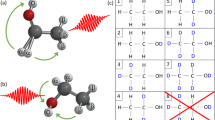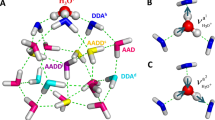Abstract
WE have photographed the molecular spectrum of hydrogen under high dispersion and obtained a series of photographs of samples with increasing amounts of the heavy isotope ranging from pure H2 to practically pure D2. We are indebted to Prof. H. S. Taylor, of Princeton, for the heavy hydrogen. In this way it was possible to decide unambiguously whether a line is due to H2, HD or D2. It is well known that a considerable part of the H2-spectrum was analysed chiefly through the efforts of O. W. Richardson and his co-workers, but there remains a great number of problems concerned with the analysis and interpretation of this complicated spectrum. The main purpose of the present investigation is to obtain additional material which can be used for a further analysis of the molecular spectrum of hydrogen and to help to clear up doubtful points in its interpretation. We are confident that in this way our knowledge of the structure of the hydrogen molecule can be greatly increased.
This is a preview of subscription content, access via your institution
Access options
Subscribe to this journal
Receive 51 print issues and online access
$199.00 per year
only $3.90 per issue
Buy this article
- Purchase on Springer Link
- Instant access to full article PDF
Prices may be subject to local taxes which are calculated during checkout
Similar content being viewed by others
References
Proc. Roy. Soc., A, 122, 688; 1929.
Bainbridge, Phys. Rev., 44, 57; 1933.
Author information
Authors and Affiliations
Rights and permissions
About this article
Cite this article
DIEKE, G., BLUE, R. Spectrum of the HD- and D2-Molecules. Nature 133, 611–612 (1934). https://doi.org/10.1038/133611c0
Issue Date:
DOI: https://doi.org/10.1038/133611c0
This article is cited by
-
Idrogeno pesante ed acqua pesante
Il Nuovo Cimento (1934)
-
�ber ultraviolette Banden des HD-Wasserstoff-Molek�ls
Die Naturwissenschaften (1934)
-
�ber eine gesetzm��ige Beziehung zwischen Kernabstand und Schwingungsenergie in Molek�len
Die Naturwissenschaften (1934)
-
Das schwere Wasserstoffisotop
Die Naturwissenschaften (1934)
Comments
By submitting a comment you agree to abide by our Terms and Community Guidelines. If you find something abusive or that does not comply with our terms or guidelines please flag it as inappropriate.



